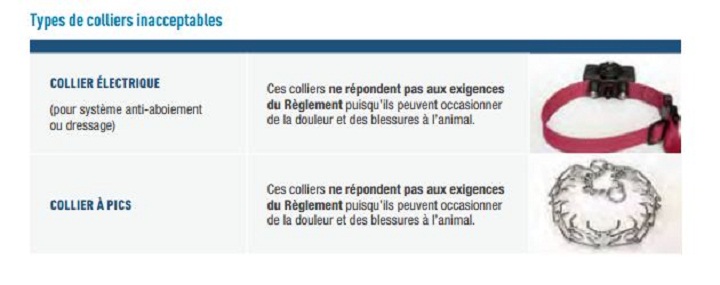PIERREFONDS, Que. — A provincial law governing the humane treatment of animals has quietly taken effect, and it may cause some Montrealers to make changes to how they deal with their dogs.

Quebec has made it clear that dog collars must not interfere with breathing, or cause an animal any pain or injury.
The province’s guide to applying animal safety regulations, published in November 2013 (pdf), describes two collars as “unacceptable”: those with recurved prongs, as well as those that give an electric shock.
According to Quebec’s Ministry of Agriculture, Fisheries and Food (MAPAC), these collars do not meet the requirements as set out in the guidelines.
Alexandre Noël, a spokesperson for MAPAC, told Global News that it wouldn’t make sense to ban specific collars, as the law would then have to be altered every time a new collar that could cause an animal pain or injury was created.
He noted that the fines for using collars that cause pain or breathing difficulties to animals are considerable: $600 to $12,000 for a first time offence, which if repeated, could triple to $1,800 to $36,000.
Those concerned about the well-being of an animal are asked to contact the ministry, who will send out an inspector to investigate.
Doggone good?
Some dog owners had already reached the same conclusion the National Assembly did when it passed the law.
“He was starting to get this ‘hack-hack,'” said Elaine Burgess, the owner of a Lab-mix called Jack.
“I knew it had to be the collar, and it really started getting bad.”
She decided to drop his prong collar for a harness, and noted that the results noticeably improved her pet’s health without hurting him.
Electric collars and invisible fences
Due to Quebec’s shock-collar recommendations, the law especially affects those pet owners that use invisible fences.
These are popular in suburban areas, because they allow a dog to roam the yard without the need to build actual fences.
The problem with these systems, said SPCA spokesperson Anita Kapuscinska, is that they can backfire.
“If an animal sees a squirrel, for instance, on the other side of an invisible fence, the dog will bolt, get a shock, but continue chasing the squirrel.”
“Now he wants to come back home, but can’t.”
According to Pierrefonds vet K. J. Goldenberg, the new legislation is currently a self-policing system.
She said that she tries to convince her clients to consider more humane alternative to restraints that offer what veterinarians call “negative feedback.”
Burgess, the lab mix owner, said switching collars made a huge difference in her dog’s health.
“It saved his neck.”
* This story has been corrected. Quebec has not banned certain dog collars; it recommends that those that hurt animals not be used.





Comments